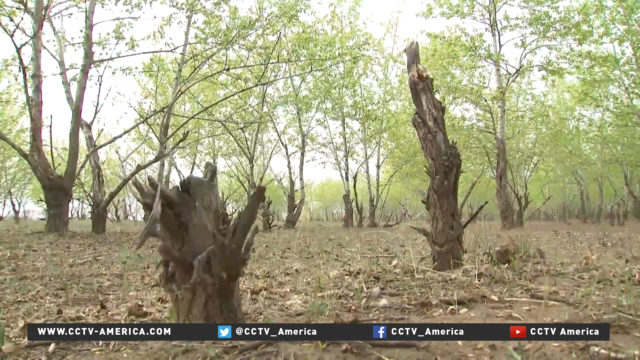Forests northwest of the capital are providing protection. But decades of dying trees have stripped Beijing and other cities of that crucial barrier.
It’s also resulted in widespread fertile land, turning into desert. Now the government is trying to reverse the process.
CCTV’s Ning Hong reports from Hebei Province, China.

It is the last barrier protecting Beijing against sandstorms from the deserts of Inner Mongolia. In Zhangbei County of Hebei Province, just over 200 kilometers to the northwest of Beijing, people have been planting trees for decades. But, in recent years, many poplar trees have died, which has made it easier for sandstorms to roll across the hills unabated.
The protection belt project was initiated in the late 1970s. But many poplars here were planted in the 1960s. Just over 200 kilometers from Beijing, the area plays a critical role in defending Beijing and other cities from waves of sand rolling in from the northwest. If the storm gets through Zhangbei County, there’s nothing left to stop it.
Trees are dying here. Many trees have been here for 50 years protecting Beijing. The dead and dying trees are so numerous that the only solution is to cut them all down and replace them with new ones. But it will take at least five years for the new trees to grow up and become effective.
The project to replace the trees began in April. Across Zhangjiakou city, 25,000 hectares of poplar was cut down, replaced with other trees which should better survive draughts and have longer lives.
In Zhangjiakou city, the forest coverage rate has been increasing, and now stands at 36 percent. Apart from the protection forest belt, there are also forests for water conservation and ecological improvement.
Professor Jianguo Liu on China Forest Recovery
The success of such programs was recently documented in an independent study. Researchers from Michigan State University said China’s forest recovery is encouraging.
CCTV America’s Mike Walter spoke to Jianguo Liu about a goal outlined by Chinese Premier Li Keqiang to cover 23 percent of China’s land with trees. He is the Rachel Carson Chair in Sustainability and Distinguished Professor of fisheries and wildlife at Michigan State University.

 CGTN America
CGTN America
